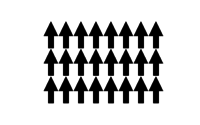
Photo from wikipedia
Based on first-principles calculations, we predict the polarization control of the interfacial magnetic phase and a giant electronically-driven magnetoelectric coupling (MEC) in Co/PbZr0.25Ti0.75O3(001). The effect of Co oxidation at the… Click to show full abstract
Based on first-principles calculations, we predict the polarization control of the interfacial magnetic phase and a giant electronically-driven magnetoelectric coupling (MEC) in Co/PbZr0.25Ti0.75O3(001). The effect of Co oxidation at the interface shared with (Zr,Ti)O2-terminated PbZr0.25Ti0.75O3 (PZT) is evidenced. The magnetic phase of the oxidized-Co interface layer is electrically switched from the ferromagnetic to the antiferromagnetic state by reversing the PZT polarization from upward to downward, respectively. A comparative study between oxidized and unoxidized-Co/PZT interfaces shows that in oxidized-Co/PZT bilayers the variation of the interface spin moment upon polarization reversal exceeds the one of unoxidized-Co/PZT bilayers by about one order of magnitude. We define a surface MEC constant αS taking into account the polarization-dependence of both the spin and orbital moments. In unoxidized-Co/PZT bilayers we obtain αS ≈ 2 × 10-10 G cm2 V-1, while a giant surface coupling αS ≈ 12 × 10-10 G cm2 V-1 is found in the case of oxidized-Co/PZT. We demonstrate that the polarization-control of the magnetocrystalline anisotropy via spin-orbit coupling is not only effective at the interface, but it extends to the Co film in spite of the interface origin of the MEC. This study shows that tailoring the nature of atomic bonding and electron occupancies allows for improving the performance of functional interfaces, enabling an efficient electric field control of spin-orbit interactions. Moreover, the non-local character of this effect holds promising perspectives for the application of electronically-driven interface MEC in spin-orbitronic devices.
Journal Title: ACS applied materials & interfaces
Year Published: 2019
Link to full text (if available)
Share on Social Media: Sign Up to like & get
recommendations!